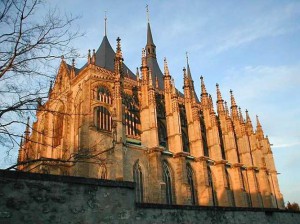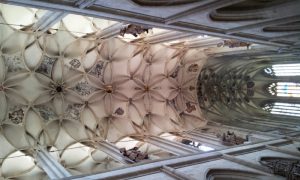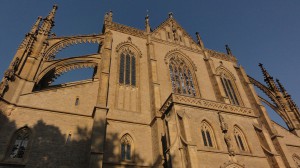Saint Barbara’s Cathedral in Kutná Hora
By Tracy A. Burns
A UNESCO world heritage site, the Gothic Saint Barbara’s Cathedral, sometimes referred to as Saint Barbara’s Church boasts fascinating double-arched flying buttresses on its exterior. Inside, medieval frescoes plus Baroque and Neo-Gothic artworks astound. It is by far the most spectacular monument in Kutná Hora and ranks among the most stunning Gothic cathedrals in Central Europe.
Kutná Hora
Kutná Hora, famous for its silver mines in medieval times, exported silver to one-third of Europe at the end of the 13th century. During the following two centuries, it was one of the most significant towns in Bohemia. In the Middle Ages, the Prague Groschen currency was minted here as well. Because the mines were prosperous, it was possible to build many impressive monuments in the town, such as the Saint Barbara’s Cathedral.
An architectural late bloomer
 The building of the cathedral was initiated in 1338 and, after many interruptions, its construction was finally completed in 1905. The lengthy building period is not unique to this cathedral: Saint Vitus’ Cathedral in Prague, the Duomo in Milan, and Saint Mark’s in Venice are also architectural late bloomers. It is no coincidence that Saint Barbara’s Cathedral is named after the miners’ patron saint. Its construction depended on the wealth of the mines, so the building was halted whenever the silver mines experienced financial troubles.
The building of the cathedral was initiated in 1338 and, after many interruptions, its construction was finally completed in 1905. The lengthy building period is not unique to this cathedral: Saint Vitus’ Cathedral in Prague, the Duomo in Milan, and Saint Mark’s in Venice are also architectural late bloomers. It is no coincidence that Saint Barbara’s Cathedral is named after the miners’ patron saint. Its construction depended on the wealth of the mines, so the building was halted whenever the silver mines experienced financial troubles.
The history of the cathedral from Jan Parléř to Matyáš Rejsek
 Inspired by his father’s designs for Saint Vitus’ Cathedral, architect Jan Parléř initiated the construction. He was responsible for the gallery chapels, which he modeled after spaces in French cathedrals. At the beginning of the Hussite wars in the early 15th century, the building was stopped, and it was not resumed until 60 years later, in 1482. In 1489 architect Matyáš Rejsek, who designed Prague’s Powder Tower, took charge and worked on the structure until 1506. He took credit for the vaulting of the cathedral, the triforium, and the stunning gargoyles on the exterior. He also decorated the spaces with many stone artifacts. In addition, Rejsek designed the balustrades of the choir with the initials W and L, commemorating rulers of the Jagiellonian dynasty that reigned throughout Central Europe from the 14th to the 16th century.
Inspired by his father’s designs for Saint Vitus’ Cathedral, architect Jan Parléř initiated the construction. He was responsible for the gallery chapels, which he modeled after spaces in French cathedrals. At the beginning of the Hussite wars in the early 15th century, the building was stopped, and it was not resumed until 60 years later, in 1482. In 1489 architect Matyáš Rejsek, who designed Prague’s Powder Tower, took charge and worked on the structure until 1506. He took credit for the vaulting of the cathedral, the triforium, and the stunning gargoyles on the exterior. He also decorated the spaces with many stone artifacts. In addition, Rejsek designed the balustrades of the choir with the initials W and L, commemorating rulers of the Jagiellonian dynasty that reigned throughout Central Europe from the 14th to the 16th century.
The history of the cathedral from Benedikt Rejt to 20th-century renovations
Later, in 1512, architect Benedikt Rejt began making many changes to the cathedral. One of his accomplishments involved designing the vaulting for Prague Castle’s Vladislav Hall. He transformed the five naves of Saint Barbara into three naves enclosed with large vaulting with helical ribs and made many radical alterations until his death in 1534. In 1626, the Jesuits got control of the cathedral, and after a fire, Baroque renovations took place. From 1884 to 1905, parts of the cathedral were remodeled, and the main altar and stained glass windows were designed.
Late Gothic decor
The oldest artifact in the three-nave cathedral is the 1308 statue of Our Lady Enthroned. Jakub of Nymburk designed the masterfully and ornately carved choir benches from 1480 to 1490. The stone pulpit hails from 1560. Amazing late Gothic frescoes dating from the end of the 15th century depict mining themes. In Smíšek’s Chapel, the family is gathered around an altar. The frescoes in this chapel are indeed valuable Late Gothic wonders, influenced by Dutch painting. In the Mint Chapel, frescoes portray miners striking Prague Groschens with mallets, illustrating the medieval technique of making coins. Working at a winch and purchasing ores are other themes addressed in the frescoes of the Hašplíř Chapel. A monumental fresco in another chapel shows Saint Christopher with the Christ Child child on his shoulders.
Baroque ornamentation
There are three Baroque chapels and numerous examples of Baroque art. A painting by J.J. Heintsche portrays the first Jesuit missionary christening a pagan prince in India. The altar of Ignatius of Loyola features a large mural of the conversion of Ignatius at Loyola Castle, rendered by Jan Karel Kovář in 1746.
Neo-Gothic decoration
 The main altar with the Neo-Gothic “Lord’s Last Supper” decoration was created from 1901 to 1905. The Neo-Gothic stained glass windows dating from the end of the 19th century and the beginning of the 20th century also enchant visitors with their themes from Czech and Kutná Hora history. The cathedral even makes up part of the background in two of the windows. One section depicts Emperor Franz Josef’s visit to Kutná Hora in 1906.
The main altar with the Neo-Gothic “Lord’s Last Supper” decoration was created from 1901 to 1905. The Neo-Gothic stained glass windows dating from the end of the 19th century and the beginning of the 20th century also enchant visitors with their themes from Czech and Kutná Hora history. The cathedral even makes up part of the background in two of the windows. One section depicts Emperor Franz Josef’s visit to Kutná Hora in 1906.
A lengthy and rich history
Saint Barbara’s Cathedral has had a lengthy and rich history. It has survived wars, mining fortunes, the Austro-Hungarian Empire, Nazism, and Communism as if Saint Barbara, also a protector against lightning and fire, had really kept it under her care.




